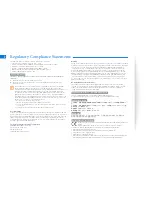
Sh
ooting
tip
s
and m
a
intenance
12
111
EN
• Use
[
n
HI]
(Spot metering highlight control).
Press the shutter button halfway at the center of the viewfinder where you wish to highlight the
whiteness. The metered part at the center will be set to appear whiter.
g
“Changing the metering mode” (P. 50)
• Use the AE bracketing function to take the picture.
If you do not know the amount of exposure compensation, try using AE bracketing. The
compensation value changes a little every time you press the shutter button. If you set a larger
exposure compensation, you can change the compensation value either upwards or downwards
based on that value and shoot the picture.
g
“AE bracketing” (P. 52)
Taking pictures of a subject against backlight
If the background is too bright compared to the subject, the exposure will be affected at the
bright parts and the subject will appear darker. This is because the camera determines the
exposure from the brightness of the whole screen.
• Set
[METERING]
to
[
n
]
(spot metering) to measure the exposure of the subject in the center of the
picture. To change the composition, place the subject in the center of the picture. While holding down
the
AEL
/
AFL
button, change the composition and press the shutter button.
g
“Changing the metering mode” (P. 50)
• Activate the flash, set the flash mode to
[
#
]
(fill-in flash) and shoot the picture. You can shoot a
subject against backlight without the face of the subject appearing dark.
[
#
]
(fill-in flash) is used for
shooting against backlight and under fluorescent and other artificial lighting.
g
“Flash mode setting” (P. 70)
Image turns out too bright or too dark
When taking pictures in
S
mode or
A
mode, the displayed shutter speed or aperture setting
may blink. A blinking display means that the correct exposure cannot be obtained. If you take
the picture as is, the picture will appear too bright or too dark. If that happens, change the
aperture setting or shutter speed.
g
“Aperture priority shooting” (P. 46), “Shutter priority shooting” (P. 47), “Exposure warning
display” (P. 123)
Unknown bright dot(s) appear on the subject in the picture taken
This may be due to stuck pixel(s) on the image pickup device. Perform
[PIXEL MAPPING]
. If
the problem persists, repeat pixel mapping a few times.
g
“Pixel mapping – Checking the image processing functions” (P. 117)
Additional shooting tips and information
Increasing the number of pictures that can be taken
The captured image will be recorded on the card. The following ways describe how to record
more images.
• Change the record mode.
The size of an image varies with the record mode. When you are not sure of the available card
capacity, change the image mode and shoot the picture. The smaller the image size and the
higher the compression, the smaller the size of the image becomes. To make the file size small,
combine the image size and compression rate and register it with
[
K
SET]
.
You can further reduce the number of pixels by setting
[PIXEL COUNT]
to fewer pixels for image
size
[
X
]
or
[
W
]
.
g
“Selecting the record mode” (P. 62), “
K
SET” (P. 93), “PIXEL COUNT” (P. 93)
• Use a card with large capacity.
The number of recordable images varies with the capacity of the card. Use a card with large
capacity.
















































